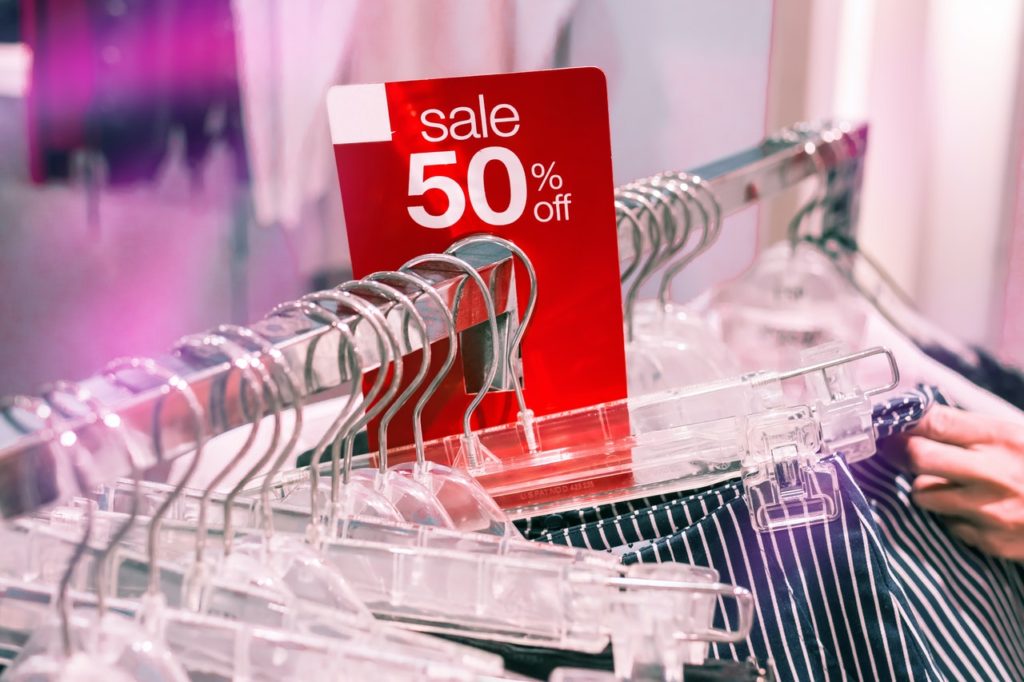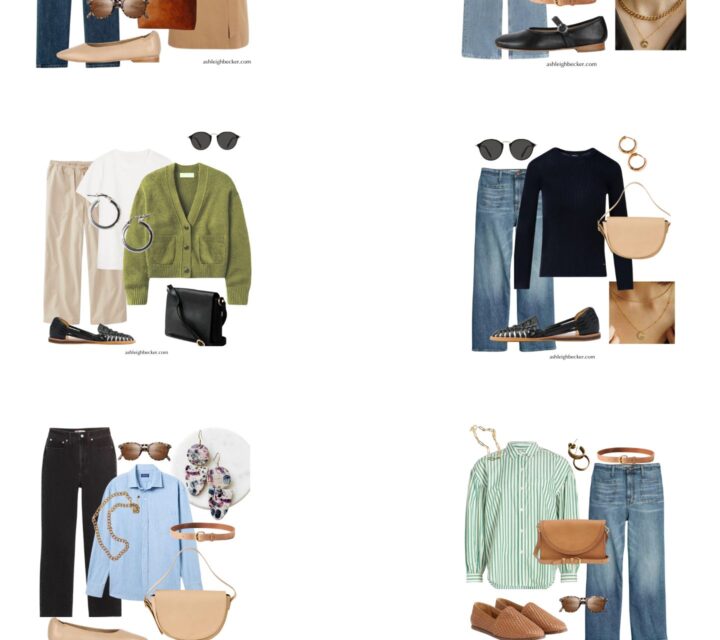What is fast fashion? What is the human and environmental impact of shopping fast fashion? I talk about making the switch from fast to slow fashion often. These are the important questions we need to ask when considering what makes clothes sustainable, the human toll of fast fashion as well as our own environmental impact.

What is fast fashion?
The most basic definition of fast fashion straight from the Oxford dictionary is inexpensive clothing produced rapidly by mass-market retailers in response to the latest trends. Good On You, a website that rates brands based on environmental factors, people and animals, describes fast fashion as “cheap, trendy clothing that samples ideas from the catwalk or celebrity culture and turns them into garments in high street stores at breakneck speed to meet consumer demand.”
Fast fashion is all about getting new runway and celebrity trends to the mass market as quickly as possible. Companies like Zara changed the fashion industry in the early 2000s by making it their mission to produce clothing from design to their store shelves in just 15 days! What once took months to produce is now happening at an extremely rapid speed.
Somehow, retail prices have managed to go down while the true cost of making clothes has actually increased. Garment workers are paying the price for this. The demands from the apparel industry on its own clothing makers are rarely considered in the cost. This begs the questions, “who is paying for our cheap clothing?” and “what are the long-term effects of cheap clothes?”
How did we get here? The history of fast fashion.
Before we consider all of the current issues, it’s helpful to take a look at what brought us here. Here’s a brief timeline:
- The Industrial Revolution of the 1800s brought machines to the textile industry and made mass production of clothing possible for the first time in history, though many still made their own clothing at home. source.
- 1911 – The first major garment factory tragedy – a fire in a New York garment factory claimed the lives of 146 workers, mostly women. source.
- The World War II era led to an increase in standardization, function and mass production of clothing. Instead of making clothing in the home, more families began purchasing their clothes. Clothing was still made to last with attention to quality and details.
- 1960s & 70s- consumer behavior started to change and consumption increased. Clothing mills started opening all over the developing world, which made outsourcing production possible to many clothing companies. Source.
- 1990s – 2000s – this is when we started to see the significant rise to fast fashion practices. Companies like H&M, Zara & Gap were some of the first to the scene. Online shopping took off at rapid speed and consumers everywhere could easily get the last trends at the lowest prices in history. Source.
- Current trends – now we are seeing ultra fast fashion where companies like Shein, Forever21, Boohoo, Fashion Nova and Pretty Little Thing are adding thousands of new styles to their websites every day. They are pushing fast fashion to the extreme and destroying the environment while they are at it. Read more about this here.
How to know if a brand is fast fashion
The fashion industry is notorious for greenwashing – a method of making baseless claims about environmental sustainability by using buzzwords to appear more sustainable than they actually are (read more on this topic here). The same is true with regards to the workers throughout fashion supply chains. Brands like H&M create “conscious” lines and use phrases like “people matter”, but really have nothing to back up those words because their manufacturing processes have not changed.
As a consumer, here are some easy ways to spot fast fashion:
- 1,000s of new styles everyday or every week, endless new releases and constant turnover of inventory.
- Offshore manufacturing in countries like Bangladesh, Cambodia, China & Southeast Asia where labor laws are not upheld, workers have no rights and there are little to no safety regulations. source.
- Constant use of cheap plastic based, synthetic materials such as polyester and rayon. The environmental impact of these Read more about microfibers in waterways here.
- No information about how clothing is made, workers’ rights or safety standards in production facilities. They may use words that sound good but have no certifications or proof from outside organizations to back it. Certifications often come with a price that ethical companies are willing to pay to ensure their workers are paid fairly, are safe and are treated with respect.
- Read the brand’s Corporate Social Responsibility Standards and ask questions. Don’t be afraid to send an email and ask about the people who make their clothes and their environmental footprint.
Why is fast fashion a problem?
There are two main factors that make fast fashion a problem: its toll on people and its environmental impact. Let’s tackle the people issue first.
Garment Workers
Real people make clothes, not machines or robots, and most of them are women. Fast fashion companies manufacture in countries where labor is cheap and standards are low. They exploit garment works by paying low wages, using factories with unsafe working conditions and no workers’ rights. Wonder how fast fashion companies get around minimum wage laws? They pay a piece rate or use a quota system. Workers are not allowed to leave for the day or get paid until they’ve met their quota which means extremely long work days without water, functional bathrooms or breaks.
Go deeper into the supply chain and you’ll uncover more issues with the way farmers are treated and required to produce at unreasonable speed with little regard to their wellbeing and mental health. The long-term health effects of pesticides leaked into waterways include, but are not limited to, cancer, birth defects and inability to reproduce. The True Cost documentary did a wonderful job shining a light on all of these issues.
Environmental Factors
There are 80 billion pieces of clothing manufactured each year. 92 million tons of textiles are wasted annually and that number is expected to increase by 60% by 2030. One garbage truck of textiles is burned or dumped into a landfill every second. 30% of clothing produced each season is never sold. Nearly 60% of all materials used in the fashion industry are plastics. Fast fashion is not eco-friendly in the least. What does the popularity of buying and supporting fast fashion brands mean for the environment?
Synthetic fabrics like polyester are often used by fast fashion companies. Polyester is derived from fossil fuels and is responsible for more microplastics ending up in our oceans. Even natural fabrics like cotton require a tremendous amount of water and pesticides for conventional growth, which is putting pressure on water supply in developing country. Toxic dyes used in fabric creation are being dumped into clean waterways and polluting rivers and streams. The fashion industry is responsible for almost 20% of global water waste pollution.

As consumers, we hold the power to demanding ethical fashion practices from the companies we support.
Fast Fashion Brands to Avoid
Who are the big players in fast fashion? Which fast fashion brands should you avoid? While there are too many to list here, this is a list of some of the biggest fast fashion offenders:
- H&M
- Shein
- Topshop
- Fashion Nova
- PrettyLittleThing
- Cider
- Missguided
- Forever 21
- Zara
- GAP (Old Navy, Banana Republic)
- Uniqlo
- Boohoo
- Cider
- Zaful
- Nike
What can I do to stop fast fashion?
We can all play a role in putting a stop to the fast fashion industry. Small changes in shopping habits can lead to big impact. I shared all about my journey from fast fashion to slow fashion here and I’ve also created a series of posts to help guide you through the process that has worked for me and many others.
The first step in switching from fast fashion to slow fashion is to stop shopping so you can train yourself to consume less. Take inventory of your wardrobe and figure out the pieces you love and the ones that do not serve you well. Learn to invest in the best quality you can afford, give secondhand shopping a try for when you need to fill gaps in your closet and then shop fair trade, slow fashion brands as often as possible.
Another important step in a slow fashion journey is to wear clothing items as long as possible by learning how to mend and repair pieces with minor holes or loose threads and take good care of your clothing by washing them according to the care instructions and hang to dry (the dryer is what causes clothing to wear out quickly). Can’t figure out how to sew or do repairs? Find a local tailor or seamstress. Simple things like hemming can be a very affordable fix for jeans that just don’t fit quite right.
Finally, when your clothing has no use left, try to find a responsible way to recycle it. Can you use it as a rag around your home? Could your kids use it for a costume? Consider responsible recycling through some of the sources Good On You provides.
Ethical, Slow Fashion Brands to Support:
I’ve created an Ethical Brand Directory with a categorical list of ethical fashion brands to support. Here are my top 10 go-to slow fashion brands:
ABLE Clothing
ABLE is challenging the culture of the fashion industry by creating transformative opportunities for women and is leading the way in wage transparency and sustainability initiatives. Over 90% of ABLE employees are women. A one-stop shop, ABLE ethically makes a full line of women’s clothing, shoes, leather handbags, and accessories.
Shop ABLE Clothing. Use code ASHLEIGH15 for 15% off.
American Giant
American Giant ethically manufactures all of their clothing in the USA allowing for a shorter supply chain. Their clothing is durable, high quality and built to last and they’re known for their high quality hoodies.
Shop American Giant. Use code SELA for 20% off your first purchase.
Tradlands
Tradlands is a slow fashion brand worth supporting. Their timeless, well-made essentials are expertly designed for the long haul and a great option for wardrobe staples.
Shop Tradlands. Use code ASHBECKER15 for 15% off your first purchase.
Nisolo
Nisolo is an ethical shoe company that pays 100% living wages and is leading the way in sustainable production through their Sustainability Facts Label. This brand ethically produces high quality leather shoes and accessories for men and women.
LA Relaxed
LA Relaxed clothing is ethically made in Los Angeles, CA. Ethical treatment of employees and all humans is the foundation of their brand. All of LA Relaxed fabrics are made from sustainably produced natural and botanical fibers.
Shop LA Relaxed. Use code ASHLEIGH20 for 20% off sitewide.
Vetta Capsule
Vetta creates capsule collections made up of 5 versatile pieces that can be turned into 30 different outfits. You can shop by capsule collection or individual pieces, and everything is made from sustainable fabrics and in responsible factories. Vetta is a slow fashion brand that creates great workwear options for women.
Pact Apparel
Pact Apparel is a slow fashion brand focused on sustainable farming, water conservation, organic fabrics, chemical free dyes, and fair trade certified factories. They make super soft underwear, outerwear and everyday clothing for men, women and kids.
Shop Pact Apparel. Use code ASHBECKER20 for 20% off any purchase.
BYTAVI
BYTAVI clothing is ethically produced in Cambodia by women who are providing fair, living wages and safe working conditions. BYTAVI uses remnant fabrics left over by the fast fashion industry that would otherwise end up in a landfill, helping to reduce industry waste.
Shop BYTAVI. Use code ASHLEIGH15 for 15% off any purchase.
Lev Apparel
Lev Apparel is a slow fashion brand that employs women at risk for human trafficking. They produce modern pieces that flatter women of all sizes and figures.
Shop Lev Apparel. Use code SELADESIGNS for 10% off your first purchase.
Fair Indigo
Fair Indigo creates high quality, basics for men and women. Their clothing is ethically produced in Peru from the finest organic cotton. Fair Indigo is a slow fashion brand that is investing in the community their clothing is made in by creating a foundation that pays for a local school teacher for employee children.
Shop Fair Indigo. Use code 22SELA for 15% off any purchase.




Great article Ashleigh! I can see you put a lot of time and energy into this. Wonderful! As the founder of a slow fashion brand that’s been around since 2000, we know exactly what you’re talking about. Maybe there’s a way for us to collaborate?
Let me know what you think.
All the best ,
Terry